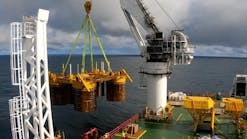Edward Frankovic
Consultant
Bilbao, Spain
The portion of the Basco-Cantabrian basin within the Basque country of northern Spain remains an attractive exploration area for hydrocarbons (Fig. 1).
Jurassic sourced oil found in seeps from Upper Cretaceous rocks has so far eluded the explorationist. In addition, possible gas reserves, like those found just south of the city of Vitoria or off Bermeo, will probably be found in the future.
With many exploration permits relinquished the past few years (Fig. 2), a large data base has become public. A 1989 interpretation of these data turned up several leads and prospects.
EARLY BEGINNINGS
The Basque country's first exploration test was drilled in 1915 to TD 656 ft (200 m). Since then, another 55 wells (444,268 ft/135,413 m) have been drilled onshore as well as a number offshore.
The area's first discovery occurred in 1960 during the drilling of 1 Castillo. Offshore Gaviota field, discovered in 1980, accounts for almost 13% of Spain's crude production and more than 98% of its natural gas production.
The deepest onshore well drilled to date is 5 Castillo (1973), which bottomed in Triassic at 5,993 m (19,662 ft.). No wells have been drilled onshore the past 6 years. Only two have been drilled the past 13 years.
Much work still needs to be done to evaluate the area. A regional seismic grid is lacking largely due to Spanish laws regarding the confidentiality of data (1 year if outside one's permit area). To get the big picture, one must patch together almost 30 low fold seismic surveys as well as some single fold data.
THE SETTING
The Basco-Cantabrian basin is underlain by Hercynian basement. A classic germanic section of Buntsandstein, Muschelkalk, and Keuper overlies the economic basement of Carboniferous age.
The massive sands of the Buntsandstein were an objective but not reached in two wells drilled in the Basque country. The 1 Boveda Bis was abandoned after a blowout at the base of Keuper. The 4 Trevino was also abandoned before reaching Buntsandstein. The formation top is now estimated to be 1,970 ft (600 m) deeper than had been projected for this well.
The Jurassic is composed of dark bituminous marls and limestones. Lias, Dogger, and Malm are represented by the above marine rocks. This depositional system ended in early Cretaceous as the Bay of Biscay began to rift open.
The Cretaceous started with typical Purbeck and Weald facies of deltas in the south and brackish water shales and mudstones in the north. The Wealdian sediments are followed by Urgonian reefal or mud mound carbonates on the highs and black, organic rich marine shales in the lows. At the end of rifting, Supra-Urgonian (Albanian) deltas, intertidal deposits, some reefs, and basin facies were deposited over the Urgonian carbonates.
The Cenomanian and Turonian are noted for pelagic sedimentation, magmatism, and calcareous turbidites. Reefal growth ended due to transgression of the sea. In the Late Cenomanian, the proto-Atlantic joined with the Tethys sea across this area. Maximum transgression took place in Middle Turonian. The Turonian also witnessed the peak of vulcanism in the area. Cenomanian and Turonian fractured shales and limestones are the reservoir facies of Castillo gas field.
Turbidite and debris flow continued through the Coniacian, Santonian, and Campanian. Reefal platforms were reestablished over salt domes, some of which had initiated their growth in Aptian. This depositional cycle ended with regressive sands. After a brief hiatus, Maastrichtian and Paleogene sands, marls, limestones, and gypsums were deposited in lagoonal and shallow marine environments. This final transgression culminated with nummulite limestones.
The Miocene was an epoch of intense tectonic activity as the Iberian Peninsula moved against Europe. Most of the presently seen folding and thrusting took place then (Fig. 3).
PLACES TO LOOK
Five land wells have been completed with gas, and two others tested gas. Eleven more registered shows of gas and-or oil. In the southern part of the basin, some oil seeps had been mined and retorted.
Based on these known occurrences, the Jurassic, Lower Cretaceous, Cenomanian, and Turonian are all exploration targets.
Modern technology and new ideas need to be applied in the search for hydrocarbons in the Basco-Cantabrian basin. Previous exploration concentrated on surface and salt-induced structures. Opportunities exist in subthrust structures (Fig. 4) and stratigraphic reservoirs like reefs and turbidite fans (Fig. 5). Subthrust and stratigraphic traps remain unidentified due to the quality of the old single and low fold data.
The economics of gas exploration has been given a boost in the Basque country due to the newly emplaced distribution system. In addition, the autonomous Basque government has expressed its willingness to take part in the risk taking through its energy exploration arm, Hidrocarburos de Euskadi, by participating in any new permits with as much as a 20% interest. Permit fees are attractive, costing as little as 1 peseta/hectare (2.11 /acre). In this way, exploration funds go where they ought to: satisfying a work commitment.
Copyright 1990 Oil & Gas Journal. All Rights Reserved.
